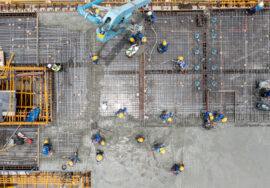The Evolution of Construction Techniques Over the Decades

Evolution of Construction Techniques Over the Decades: Construction techniques have evolved significantly over the decades, reflecting advancements in technology, materials, and architectural design. From traditional methods used in ancient times to the sophisticated, high-tech processes of today, the evolution of construction has transformed how buildings are designed, built, and maintained. This evolution has not only improved efficiency and safety but also allowed for the creation of more sustainable and resilient structures.
Early Construction Methods
Ancient Techniques
Early construction relied on locally sourced materials and manual labor. Techniques such as mudbrick construction, stone masonry, and timber framing were widely used. Ancient civilizations like the Egyptians, Greeks, and Romans made monumental advances in construction, particularly in the development of architectural structures like pyramids, temples, and aqueducts. The Roman Empire, for example, is credited with innovations such as the arch and the use of concrete, which allowed for larger and more durable buildings.
Medieval Construction
During the medieval period, construction techniques became more specialized. Stone masonry reached new heights with the construction of castles, cathedrals, and fortifications. Builders relied heavily on manual labor, and tools were relatively primitive, such as hammers, chisels, and hand saws. Structures from this era were built for strength and longevity, which is evident in the surviving Gothic cathedrals and medieval castles that still stand today.
The Industrial Revolution and the Birth of Modern Construction
The Introduction of Steel
The Industrial Revolution in the 18th and 19th centuries marked a turning point in construction techniques. The invention of steel as a construction material revolutionized the industry. Steel provided unprecedented strength and flexibility, allowing for the construction of taller buildings and longer bridges. This period saw the rise of iconic structures such as the Eiffel Tower and the Brooklyn Bridge.
Prefabrication and Mass Production
With the advent of industrialization came the concept of prefabrication, where building components were manufactured off-site and assembled on-site. This significantly reduced construction time and costs. Mass production techniques, driven by advancements in machinery, allowed for the quick construction of residential and commercial buildings, particularly during times of rapid urbanization.

20th Century Innovations
Reinforced Concrete
One of the most significant innovations in 20th-century construction was the development of reinforced concrete. This material, which combines concrete with steel reinforcement, offered both strength and flexibility. It became a key material in the construction of skyscrapers, bridges, and large infrastructure projects. Reinforced concrete allowed architects to push the boundaries of design, leading to the development of modernist architecture.
Skyscrapers and Urbanization
The early 20th century also saw the rise of the skyscraper as cities expanded vertically to accommodate growing populations. The use of steel frames and reinforced concrete made these towering structures possible. Iconic skyscrapers like the Empire State Building and the Chrysler Building symbolized the rapid growth of urban centers.
Mechanization and Heavy Machinery
The introduction of heavy machinery, such as cranes, bulldozers, and excavators, drastically changed the construction landscape. These machines reduced the reliance on manual labor and increased the speed of construction. Projects that would have taken years to complete manually could now be finished in a fraction of the time.
Modern Construction Techniques
Green Building and Sustainability
In the 21st century, sustainability has become a central focus of construction. Green building techniques prioritize energy efficiency, resource conservation, and environmental sustainability. This shift has led to innovations such as solar panels, green roofs, and the use of recycled materials. LEED (Leadership in Energy and Environmental Design) certification has become a standard for sustainable building practices.
Building Information Modeling (BIM)
Technology has transformed modern construction techniques, particularly with the rise of Building Information Modeling (BIM). BIM is a digital tool that allows architects, engineers, and contractors to create and manage building designs in a collaborative environment. It enables 3D modeling, real-time data sharing, and more efficient project management, reducing errors and improving the overall quality of construction.
Modular Construction
Modular construction, a modern take on prefabrication, involves constructing sections of a building off-site in a factory-controlled environment and then assembling them on-site. This method is becoming increasingly popular due to its efficiency, cost-effectiveness, and sustainability. Modular construction reduces waste, speeds up the building process, and ensures a higher level of quality control.
Smart Buildings and Automation
The integration of technology into buildings has led to the development of smart buildings, which are equipped with automated systems for lighting, heating, cooling, and security. These systems improve energy efficiency, enhance safety, and provide greater convenience for occupants. The use of sensors, IoT (Internet of Things) devices, and AI-driven systems is shaping the future of construction and building management.
Conclusion
Evolution of Construction Techniques Over the Decades; The evolution of construction techniques over the decades has been driven by advancements in technology, materials, and sustainability. From the use of basic tools and manual labor in ancient times to the rise of skyscrapers, green buildings, and smart technology, construction has come a long way. As the industry continues to evolve, the focus will likely remain on efficiency, sustainability, and innovation, paving the way for even more groundbreaking construction methods in the future.
External Resources for Legal Guidance
Read more related articles to enhance your knowledge and make informed decisions
10 Essential Steps in the Building Construction Process
How to Choose the Right Materials for Your Construction Project








